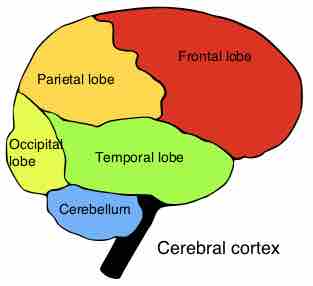Brain lobes were originally a purely anatomical classification, but we now know they are also associated with specific brain functions. The telencephalon (cerebrum), the largest portion of the human brain, is divided into lobes like the cerebellum. If not specified, the expression "lobes of the brain" refers to the telencephalon. There are four uncontested lobes of the telencephalon:

Cerebral lobes
The four lobes (frontal, parietal, occipital, and temporal) of the human brain are depicted along with the cerebellum.
The Frontal Lobe
The frontal lobe is an area in the mammalian brain located at the front of each cerebral hemisphere and positioned anterior to (in front of) the parietal lobe and superior and anterior to the temporal lobes. It is separated from the parietal lobe by a space between tissues called the central sulcus and from the temporal lobe by a deep fold called the lateral (Sylvian) sulcus. The precentral gyrus, forming the posterior border of the frontal lobe, contains the primary motor cortex, which controls voluntary movements of specific body parts.
The frontal lobe contains most of the dopamine-sensitive neurons in the cerebral cortex. The dopamine system is associated with reward, attention, short-term memory tasks, planning, and motivation. Dopamine tends to limit and select sensory information that the thalamus sends to the forebrain. A report from the National Institute of Mental Health indicates that a gene variant that reduces dopamine activity in the prefrontal cortex is related to poorer performance in that region during memory tasks; this gene variant is also related to slightly increased risk for schizophrenia.
The frontal lobe is considered to contribute to our most human qualities. Damage to the frontal lobe can result in changes in personality and difficulty planning. The frontal lobes are the most uniquely human of all the brain structures.
The Parietal Lobe
The parietal lobe is a part of the brain positioned above (superior to) the occipital lobe and behind (posterior to) the frontal lobe. The parietal lobe integrates sensory information from different modalities, particularly spatial sense and navigation. For example, it comprises the somatosensory cortex and the dorsal stream of the visual system. This enables regions of the parietal cortex to map objects perceived visually into body coordinate positions.
Several portions of the parietal lobe are also important in language processing. Also, this lobe integrates information from various senses and assists in the manipulation of objects. Portions of the parietal lobe are involved with visuospatial processing.
The Occipital Lobe
The two occipital lobes are the smallest of the four paired lobes in the human cerebral cortex. Located in the rearmost portion of the skull, the occipital lobes are part of the forebrain. At the front edge of the occipital there are several lateral occipital gyri separated by lateral occipital sulci. The occipital lobe is involved in the sense of sight; lesions in this area can produce hallucinations.
The Temporal Lobe
The temporal lobe is a region of the cerebral cortex located beneath the lateral fissure on both cerebral hemispheres of the mammalian brain. The temporal lobes are involved in many functions, such as retaining visual memories, processing sensory input, comprehending language, storing new memories, feeling and expressing emotion, and deriving meaning. The temporal lobe contains the hippocampus and plays a key role in the formation of explicit long-term memory, modulated by the amygdala. It is involved in the senses of smell and sound as well as in processing of complex stimuli.
Adjacent areas in the superior, posterior, and lateral parts of the temporal lobes are involved in high-level auditory processing. The temporal lobe is involved in primary auditory perception such as hearing and holds the primary auditory cortex. The superior temporal gyrus includes an area where auditory signals from the ear first reach the cerebral cortex and are processed by the primary auditory cortex in the left temporal lobe.
The areas associated with vision in the temporal lobe interpret the meaning of visual stimuli and establish object recognition. The ventral part of the temporal cortices appear to be involved in high-level visual processing of complex stimuli such as faces (fusiform gyrus) and scenes (parahippocampal gyrus). Anterior parts of this ventral stream for visual processing are involved in object perception and recognition.